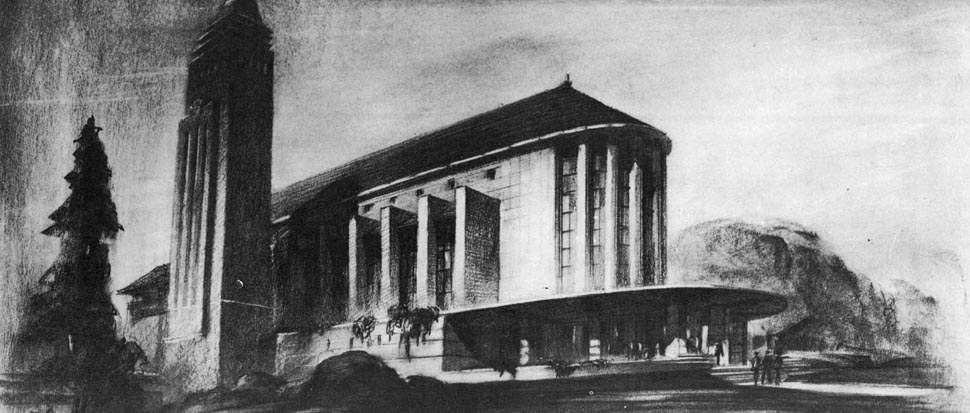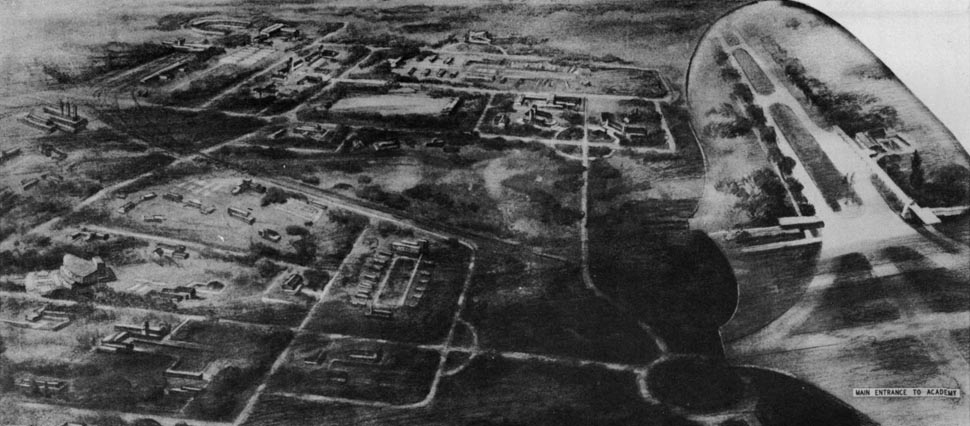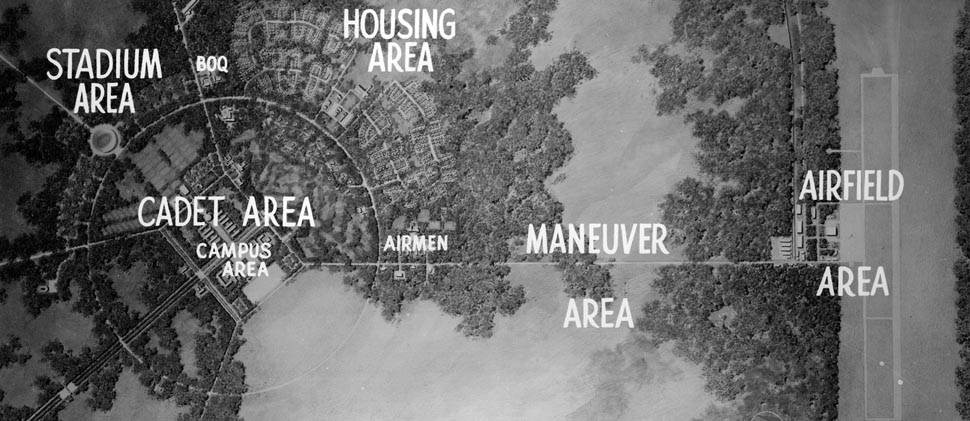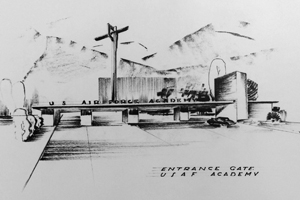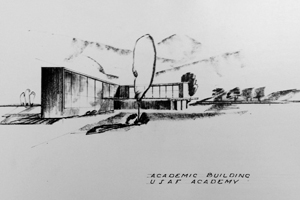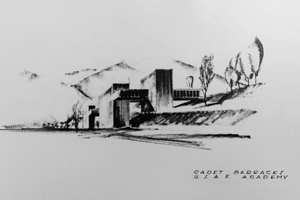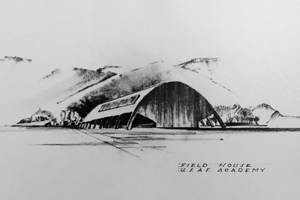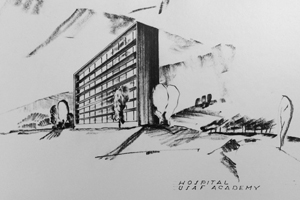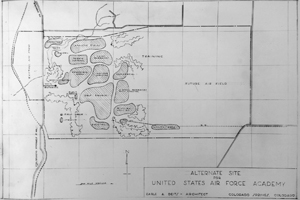Report of the Air Force Academy
Planning Board Study
January 1949
The Necessity for the United States Air Force Academy
The disposition of the people of the United States is historically so unwarlike that to the vast majority it seems unusual for a person to seek a career in the profession of arms. This fact was recognized early in our national life and the leaders at the time saw the necessity for establishing an institution devoted to training a specified number of American youths in the art of war and instilling in them, through the United States Military and Naval Academies, the desire to serve their country as members of the military profession. Thus, the American people established the precedent of educating a selected number of young men each year for training for the service of their country as career officers into the two branches of its Armed Forces.
The rapid rise to prominence of Air Power and its frightening possibilities are factors with which both civilians and the military became all-too-familiar during the recent war. Its instruments and techniques have caused the establishment of new schools for the study of their application and occasioned the organization of staff and personnel especially equipped to meet their problems. This was specifically recognized by Congress when, on September 19, 1947, it created the Air Force as a third and co-equal branch of the armed services and assigned to it the responsibility for its full share in maintaining the safety and security of the United States.
The necessity for specialized studies and trained personnel in this new area of warfare was recognized during World War I, and the Military Aeronautics Department of the Army, the predecessor of the United States Air Force, during the winter of 1918 in the spring of 1919, advocated establishment of an Air Academy, ”which would bear the same relation to the Air Service that West Point does to the Army.” Further study resulted in the introduction of various bills from 1922 to 1944. Other legislation proposed in 1945 and 1946 kept the question before Congress and a matter of study and consideration before the War Department and the Air Force.
The United States Air Force is now the only branch of the nation’s armed services lacking a center for the education of its future leaders in the intricacies of its own particular field. These leaders will be held strictly accountable by their countrymen in a not unforeseeable future for maintaining control of an area who’s finite limitations are defined only by the extent of the atmosphere, the mediums of transmission, and the skill of its operators.
Educational Status
Among the serious problems facing the United States Air Force is that of establishing a system of undergraduate education which will prepare officers for careers in that service. Because the educational prerequisites for commissioning have had to be lowered to secure the necessary officers, the number of non-college compared to college graduates within the Air Force has been increasing each year. This has resulted in an increasing number of officers who do not measure up to the standards of education required for the execution of their duties at the highest peak of efficiency. The Air Force needs a system of procurement that will provide an adequate number of college educated, uniformly trained officers with the character and personal attributes desired–a system that will give stability to the officer corps and unity to the objectives and ideals of its members.
Traditional Sources
The army is currently furnishing the Air Force 40% (approximately 200 per year) of the graduates at West Point and the Navy has offered 7% (approximately 45) of each graduating class from Annapolis. This maximum of 250 regular officers per year is a temporary measure and not only falls far short of meeting the needs of the Air Force but deprives the other services of their vitally needed officers, who have been educated for service with land or sea forces.
The main sources of officers in the past have been the Aviation Cadet program, Air Reserve Officers Training Corps, and Officer Candidate Schools. These sources are now able to provide approximately 500 annually of the type of career officers needed by the regular Air Force of which the Air ROTC is the main source at present. This is still about 500 short of the required number, and it is this deficiency of 500 that the proposed Air Force Academy will eliminate. Numbers available from this source very in accordance with economic world conditions. In years of prosperity the enterprising college graduate who is out to make his fortune is not greatly interested in a military career. The Air Force cannot build safely and surely for the future if the regular officer procurement is based on unreliable and variable sources.
Urgency
West Point was founded at the insistence of Washington, Knox, Hamilton, Jefferson, and Munro. These men knew from bitter experience the need of a school for the professional training of officers–officers who could establish and maintain the standards of the Regular Army and impart the same standards to the militia and the citizenry when the latter were called to arms in times of national emergency.
It can hardly be disputed that maintaining national security or, in the last extremity, the conduct of war, is such a serious business that it should be entrusted only to the most carefully trained and highly qualified men. Air Force leaders of the future should have the benefit of the best training available for practical reasons but the preservation of the lives and fortunes of the nation they ultimately rests in their hands. The Air Force, with its mission of vital importance to the nation, should be provided with an undergraduate institution which concentrates all of its efforts on producing able and properly equipped Air Force leaders.
The Mission of the United States Air Force Academy
The mission of the United States Air Force Academy will be threefold: 1, to provide an assured and constant source of approximately fifty percent of the annual regular officer replacement requirements of the Air Force, 2, to provide these officer replacements with the requisite educational background essential to career service in the Air Force and, 3, to provide an adequate officer corps which may be augmented in times of war or national emergency.
Specifically, the aim of the Air Force Academy will be to produce an officer who will be:
a. Well-grounded in Air Force principles, practices and procedures.
b. Broadly and soundly educated in the humanities, sciences and military studies.
c. Conscious of the mission and responsibilities of the profession of arms.
d. Devoted to his career and sensible of his obligation to his country and his service.
e. Motivated to work for the preservation of peace and willing to fight for its effective accomplishment.
f. Instilled with a high sense of loyalty, duty and the subordination of his individual desires for the common good.
g. Skilled in human relations and possessed of a knowledge of the world and its peoples.
h. Respectful of the rights and liberties of individuals, institutions and nations.
i. A calm, effective, resourceful leader.
j. Receptive of new ideas and learning.
k. A man who knows how to “win,” and how to take his place on a winning team.
l. An honored representative of the Air Force.
The Air Force Academy will offer a program involving inspiration, indoctrination, and instructions to develop the above attributes within the Air Cadets and provide the educational background suitable for career officers. This program will not be an end in itself but, rather, will serve as a background upon which the career officer may continue to build throughout his service for the maximum utilization of his talents and abilities within the Air Force organization.

